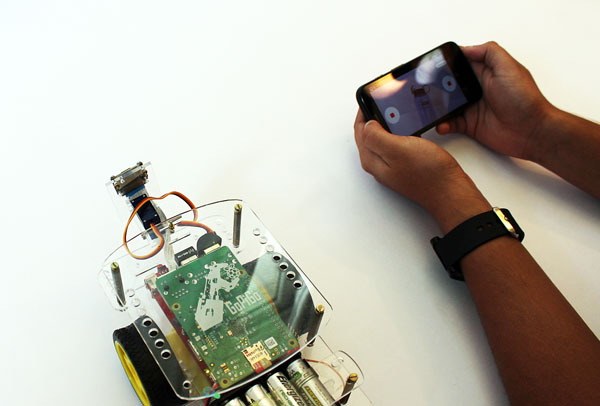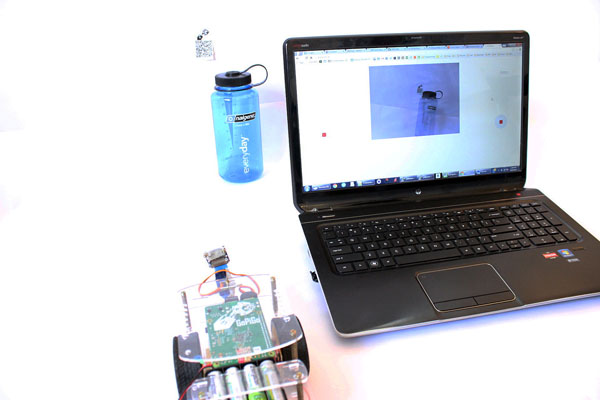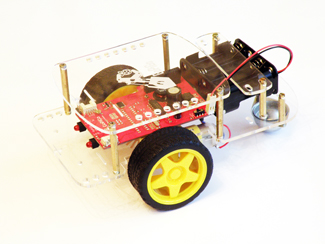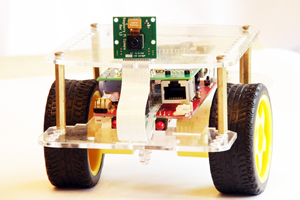This project is aimed at building a Robot that allows for streaming of video and control from a web browser
- Here are some pictures of what you will end up with. This project has been built upon the Dexter Industries GoPiGo robot.
- Dexter Industries offers a modular robot with excellent video, printed tutorials to getting you up and running in a few hours.
- The initial Dexter Industries robots were based on the Rapsberry Pi 2 (which is what my robot is based upon) but have now upgraded their robot package to support the Raspberry Pi 3.
- You can read more about this robot and pick your up from Dexter Industries
- A lot of the code and functions included here are leveraged from Dexter Industries examples which are licensed under GPL.
- To start we need to clone the python project repository which will give us access to the code we need.
- We can then work on resolving a bunch of depedencies and install some software. So let's get going.
bash# git clone https://github.com/tangowhisky37/RaspiPythonProjects.git
- Change into the folder containing the code for the browser controller GoPiGo robot.
bash# cd Gopigo_Robot_Browser_Controlled
- Let's get started with the installation. But before we do that we need to make the browser_stream_setup.sh script executable
bash# chmod +x ./browser_stream_setup.sh
- Execute the script to kick off the installation
bash# sudo ./browser_stream_setup.sh
- During the installation you will see errors about mjpg-streamer. Don't stress we will manually install them next.
- Once the installer has done it's job open up a console and download the fork of mjpg-streamer for the Raspberry Pi from github.
bash# git clone https://github.com/jacksonliam/mjpg-streamer
- The above project is a fork of http://sourceforge.net/projects/mjpg-streamer/ with added support for the Raspberry Pi camera via the input_raspicam plugin.
- mjpg-streamer is a command line application that copies JPEG frames from one or more input plugins to multiple output plugins.
- It can be used to stream JPEG files over an IP-based network from a webcam to various types of viewers such as Chrome, Firefox, Cambozola, VLC, mplayer, and other software capable of receiving MJPG streams.
- It was originally written for embedded devices with very limited resources in terms of RAM and CPU.
- Its predecessor "uvc_streamer" was created because Linux-UVC compatible cameras directly produce JPEG-data, allowing fast and perfomant M-JPEG streams even from an embedded device running OpenWRT.
- The input module "input_uvc.so" captures such JPG frames from a connected webcam. mjpg-streamer now supports a variety of different input devices.
- You must have cmake installed. You will also probably want to have a development version of libjpeg installed. We used libjpeg8-dev based on guidance from the developers. e.g.
- So let's proceed, install the dependencies for mjpg-streamer and then compile, build and install mjpg-streamer from source.
bash# sudo apt-get install cmake libjpeg8-dev
- The following commands will build and install all plugins that can be compiled.
bash# cd mjpg-streamer-experimental bash# make bash# sudo make install
- With all the installation now out of the way you are now able to proceed with launch of the streaming, browser control program.
- Make robot_web_server.py executable
bash# chmod +x robot_web_server.py
- Run robot_web_server.py which launches the Python Tornado web server
- Open a web browser on any computer or mobile device and enter the following in the address bar:
http://IP_Address_Of_Your_Raspberry_Pi:98
- The page that hosts the streaming video and browser control application runs on the local IP address of the Pi on port 98
- The video stream would load up and you can use the joystick on the screen to control the GoPiGo
Enjoy and keep hacking !!!



